Recipes-in 10 lb. batches
Jane,
Here is a simple recipe that we have worked with over the years.
Love, Betsy

Sauerkraut
10 lbs. organic cabbage at room temp*, take out most of core and shred by hand or food processor
1/4 cup Celtic sea salt, dried and ground (or use other unrefined salt ground up), about 2 oz.
4 tsp whole caraway seed
few crushed juniper berries
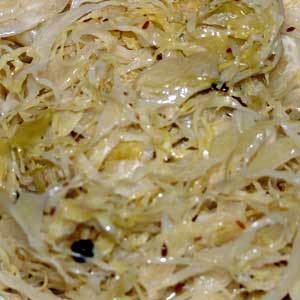 Mix well and pack tightly into container using a fist or other device as the lacto-fermentation takes place in an anaerobic environment. Sauerkraut has been made successfully in 1 quart glass canning jars, 2 liter glass jars with clamp lid, and larger food grade plastic pickle and food containers. For the larger containers an air lock system works best to allow the carbon dioxide to bubble out and prevent oxygen from getting in. For the 1 quart or 2 liter containers a fairly snug lid will suffice.
Mix well and pack tightly into container using a fist or other device as the lacto-fermentation takes place in an anaerobic environment. Sauerkraut has been made successfully in 1 quart glass canning jars, 2 liter glass jars with clamp lid, and larger food grade plastic pickle and food containers. For the larger containers an air lock system works best to allow the carbon dioxide to bubble out and prevent oxygen from getting in. For the 1 quart or 2 liter containers a fairly snug lid will suffice.
Juices will rise to the top with packing and will be the top “seal” for kraut. To keep the cabbage mixture submerged, a layer of whole cabbage leaves wedged in using a cabbage core or a weight on top can be used.
Keep container at room temperature, 65 – 68F, for 2 weeks before moving to cooler space for 6 more weeks. Taste the cabbage after 2 weeks to determine if it is sufficiently soured. If it is not, keep it at room temperature for a few more days.
* At room temp the cabbage is quicker to wilt and have the juices drawn out of it by the salt.
Fermented Carrots
10 lbs. carrots, scrubbed and grated
1 lb. shredded cabbage, as above
1/4 cup Celtic seasalt, as above
1/4 lb. or 4 oz. grated fresh ginger
4 oz. grated onion
Mix well and pack accordingly, as above.
Fermented Beets
10 lb. fresh raw beets, cleaned and peeled if necessary
1 lb. shredded cabbage, as above
1/4 cup Celtic seasalt, as above
1/8 cup whole anise seed
1/16 cup ground allspice
OR
1/8 cup dried tarragon
Mix well and pack accordingly as above. Note that beets require 75-80 degrees F for first two weeks of fermentation.
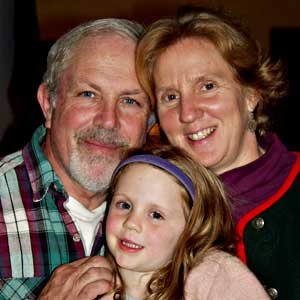 Betsy Cashen studied nutrition at Cornell University and has been a practicing dietitian since 1986, working in both conventional and anthroposophical settings.She also spent several years making a livelihood as co-manager of a biodynamic farm.Currently she contracts with the Early Intervention Program to do nutrition education in the home for families with young children with developmental delays. She lives in Claverack, NY. If you want to send her a message, use the Satya Center contact us form.
Betsy Cashen studied nutrition at Cornell University and has been a practicing dietitian since 1986, working in both conventional and anthroposophical settings.She also spent several years making a livelihood as co-manager of a biodynamic farm.Currently she contracts with the Early Intervention Program to do nutrition education in the home for families with young children with developmental delays. She lives in Claverack, NY. If you want to send her a message, use the Satya Center contact us form.
Betsy Cashen and her family put up batches of saurkraut each fall in 10 pound batches. Curtis & I have been the lucky recipient of many tasty, tangy & healthful jars of this delicious kraut over the years.
Making Sauerkraut-A Pictorial Essay
Gathering around the pots, two to a shredder and placing the (weighed out) biodynamic cabbage in the shoot, moving it back and forth over the blade being careful to keep cabbage  in there, and fingers away from the blade, watching the lovely shredded cabbage pile up. Alternating sprinkling the salt and spices, all pre-measured into the pot as we go.
in there, and fingers away from the blade, watching the lovely shredded cabbage pile up. Alternating sprinkling the salt and spices, all pre-measured into the pot as we go.
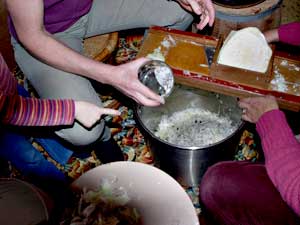 Adding the Salt
Adding the Salt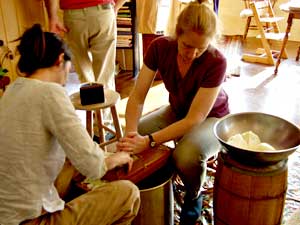 Measured Cabbage being shredded
Measured Cabbage being shredded Shredded Cabbage
Shredded Cabbage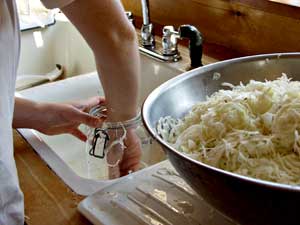 Packing the Cabbage in Jars
Packing the Cabbage in Jars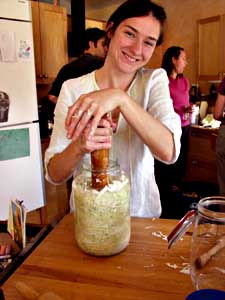
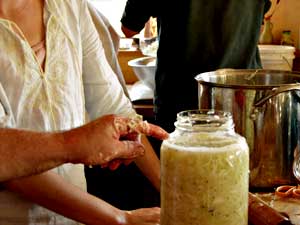
Mashing the Cabbage to bring up juices. Checking the amount of brine to leave in the jar and adding more cabbage if necessary.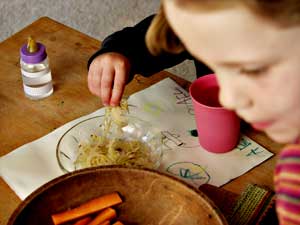 Kids snack on last year's kraut.
Kids snack on last year's kraut.
All in all, a wonderful community effort, we each carried our jars home to sit in a warm place for two weeks or so, checking every now and then to make sure the brine covers the kraut, and checking by smell for the right moment to put the kraut in a cold dark place for the year.
Thanks to Betsy & Chris for making this a wonderful event!

